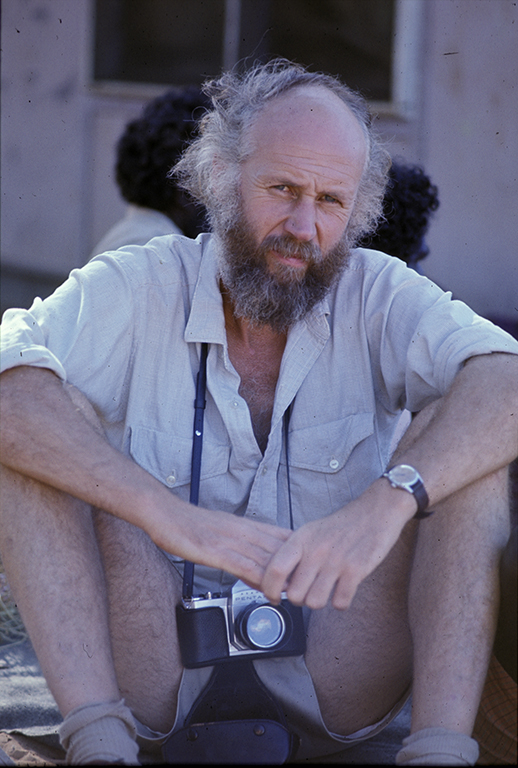Many articles and books have been written and published about the importance of the documentary films of Ian Dunlop. I would like to pay tribute to the work Ian undertook in collaboration with the Australian Institute of Aboriginal Studies (AIAS, now known as AIATSIS).
The AIAS commissioned a vast amount of original film material through its film unit which operated from 1962 to 1988. These resources are complemented by the extensive work of Ian Dunlop at the Commonwealth Film Unit (formerly Film Australia) and by the People of the Western Desert series undertaken in collaboration with AIAS.

Ian Dunlop in Yirrkala (East Arnhem Land), August 1971. Photographer: Philip Robertson. AIATSIS Collection, DUNLOP.I06.CS-000132465.
Ian Dunlop in Yirrkala (East Arnhem Land), August 1971. Photographer: Philip Robertson. AIATSIS Collection, DUNLOP.I06.CS-000132465.
In 1962, Dunlop travelled to Ngaanyatjarra-Giles weather station about 330 kilometres west of Uluru to produce ethnographic films with AIAS funding. He had escorted two newly-arrived families from a government settlement back to their country where they showed him various aspects of their life in the desert. This resulted in the publication of an acclaimed nineteen-part series of films made over the next six years entitled People of the Australian Western Desert.
In 1967, Dunlop edited three parts of the series into a cinema release version of their activities called Desert People. This film went on to win even greater acclaim, including a prestigious Golden Lion award at the Venice Film Festival. It was screened all over the world and for many people the film defined Aboriginal Australia.
Michael Leigh (former AIATSIS film archivist) notes on the National Film and Sound Archive of Australia website:
Dunlop also promoted a greater understanding of earlier ethnographic film, overseeing the preservation and screening of Baldwin Spencer’s films that then lay in disuse and neglect. He used this footage in screening programs around the world and lectured on the history of ethnographic film in Australia, building on the international impetus that resulted from the 1966 UNESCO conference.
Later in his career Dunlop concentrated his filming at Yirrkala in Arnhem Land and formed a close, collaborative relationship with the great painter Narritjin Maymuru. Unfortunately this type of complex, extended ethnographic filmmaking project was too costly to fund and maintain. It also became too difficult to defend politically in the face of the growing vociferous debate regarding the politics of representation that arose following the Whitlam Government’s election in 1972. Both the AIAS and Commonwealth Film Unit ceased making ethnographic films around 1985.
In 1996, during a temporary six month transfer from the National Film and Sound Archive (NFSA) to AIATSIS to manage the film archive, I first met Ian who was re editing films with editor Pip Deveson in the next room. I took an interest in what they were doing and in return they asked me about archival preservation of their films.
It was the start of a long and interesting friendship. We spent many lunch times discussing Ian’s films and film in general. In 1998 our paths crossed again when Ian was asked to participate in a reference group formed by the NFSA to help categorise their vast collection of Indigenous film. The Indigenous Reference Group (IRG) meetings were always lively with Ian being one of the most animated participants of the group.
Soon after in 2000, Ian and his wife Roey came to Canberra to be close to their son Michael and his family. It wasn’t long before Ian had an office at the ANU’s Digital Hub alongside his former colleague and film maker Kim Mackenzie.
I started visiting the Hub to talk with Kim about the possibility of completing his unfinished film projects in the Institute’s film archive. For me, those lunch times spent under the trees in the garden behind the Hub with Kim, Ian, and Roey were a source of great information and understanding about the AIAS film unit.
Ian was also a marvellous story teller. His adventures in Papua New Guinea in the 1950s lugging heavy 35mm cameras through the jungle to film ceremonies always seemed somehow much larger than life. I always thought Ian was a romantic at heart. He told me about how he had transferred his initial choice of study at the University of Sydney to be closer to a student who had taken his eye. That decision guided the rest of his life with Roey.
I will always remember Ian as a gentle and kind soul. It is through his films that Ian has had a profound influence on the lives of many First Nations people. Perhaps one of his most influential legacies has been to the Yolngu People who established the Mulka Centre, a media archive at Yirrkala in the Northern Territory. Central to their collection is the 22 films made over 30 years comprising the Yirrkala Film Project made with Ian Dunlop, ensuring the preservation of knowledge and culture to be shared with many generations to come.
Unlike the negative portrayal of Aboriginal communities in mainstream Australian media, the intention of Dunlop’s films was to show a positive side to a homeland and how living on homelands are a means of maintaining a connection to Country and a unique way of life.
AIATSIS holds more than 5000 photographs (mostly colour slides) donated by Ian. The images were taken during his work with the Commonwealth Film Unit/Film Australia between 1964 and 1982 at various locations but particularly Western Desert region of WA; ‘People of the Western Desert’, (1964-67), Yirrkala (1970-1982), Yayayi and Papunya (1974) and East Arnhem Land (1976).